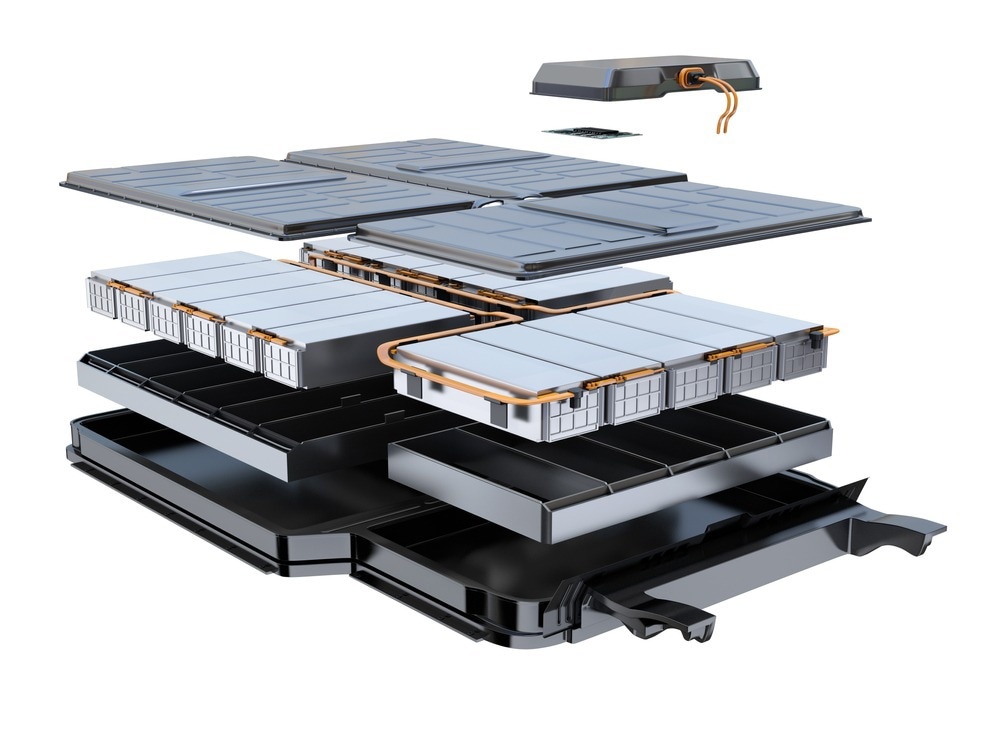Writing in the journal ACS Energy Letters, a team of scientists from the Republic of Korea has explored new high-energy organic electrodes with long lives for use in rechargeable aqueous batteries.

Study: High-Energy and Long-Lasting Organic Electrode for a Rechargeable Aqueous Battery. Image Credit: Chesky/Shutterstock.com
Background to the Research
Batteries are a key energy storage technology in the transition toward a decarbonized economy. Surging demand for batteries in electric vehicles and renewable energy technologies has prompted the large-scale manufacturing of lithium-ion batteries in recent years.
There is major concern amongst researchers, industry, and governmental bodies as to whether the manufacture of lithium-ion batteries is sustainable due to limited resources, high energy and capital costs for extraction and processing, social problems associated with mining operations, and safety issues.
Coupled with these concerns are challenges with electrode chemistry, with many conventional lithium-ion battery designs requiring the use of heavy transition metals. Some critical issues associated with the use of heavy transition metals are the cost and scarcity of raw resources and breaking the electrode material's specific capacity ceiling, which is hindered by the transition metal’s heavy weight.
To overcome the challenges associated with electrode chemistry, researchers have investigated alternative materials for use in this key battery component. Redox-active organic materials, or ROMs, have emerged as suitable candidates as they are cost-effective, sustainable, and their raw materials are extremely abundant. ROMs can attain higher specific capacities than their inorganic transition metal counterparts.
ROMs can be tuned by tailoring their molecular structure to produce different physiochemical and electrochemical properties. Amongst the various ROMs evaluated by researchers, multi-electron-redox molecules have emerged as promising high energy density candidates for use in battery electrodes.
Amongst these, DMPZ is particularly attractive as an electrode material due to its superior energy density that can exceed conventional electrode materials such as LiCoO2. However, despite its potential, the dissolution of DMPZ particles in electrolytes hinders the practical implementation of this electrode material. Studies have attempted to overcome this issue with limited success.
The Paper
The paper has explored the compatibility between DMPZ electrode materials and electrolyte solvents with the aim of improving aqueous battery design. Deep learning was employed in the study, which can predict organic molecule dissolution tendencies and thereby aid the optimal design of an electrode/electrolyte combination that has the best stability and lifespan.
Suitable solvents were fast screened using machine learning, and additionally, the technique was employed to predict solvation properties. There is a potentially large pool size of solvent and salt combinations, which would hinder conventional screening methods, making machine learning a necessary choice.
By combining machine learning screening methods and experimental verifications, the authors evaluated the optimal design of an aqueous battery utilizing DMPZ electrode salts. Additionally, this combined approach offers general insights into the interplay between the electrolyte solvents and the solubility of organic redox-active molecules.
DMPZ is vulnerable to dissolution in some electrolyte solvents such as diethyl carbonate and dimethyl carbonate, but in solvents such as ethyl carbonate and water, this dissolution is mitigated. In water, its dissolution potential is lowest, which strongly indicates that DMPZ is applicable as an electrode in aqueous batteries. Comparative dissolution tests confirmed DMPZ’s different intrinsic solubilities.
Study Findings
It was confirmed by the authors that, in aqueous electrolytes, DMPZ electrodes possess stable and reversible redox behavior. Additionally, high initial discharge capacities were observed, with 85% capacity retained over two hundred cycles. Experimental observations confirmed that DMPZ works best with aqueous electrolyte solvents, and the authors have stated that reducing DMPZ solubility could improve the cycle stability of the electrode/electrolyte design.
There is one key limitation with the paper’s proposed aqueous battery system, however. DMPZ displays a characteristic double redox activity, and the system’s inability to deliver this limits its delivered capacity, which could not satisfy the theoretical value. This could be due to the setup’s low charging voltage limit.
Oxygen evolution is induced when the electrode is charged over the oxygen evolution potential, which leads to fast cycle decay due to the electrochemical stability of the electrode becoming extremely deteriorated.
An optimized hybrid aqueous electrolyte was developed utilizing NaClO4 salt to widen the electrochemical stability window, exploiting DMPZ’s full redox capability whilst suppressing oxygen evolution.
The novel machine-learning optimized DMPZ/hybrid NaClO4 aqueous electrolyte battery design presented in the paper achieved favorable performance, which exceeds currently reported organic electrodes. The system possesses excellent durability and capacity retention up to five thousand cycles, with a less than a 0.5% cycle degradation rate per day and outstanding energy density achieved in the design.
In summary, the paper has demonstrated the indispensability of understanding the compatibility between electrode and electrolyte for the design of highly efficient, stable, and durable aqueous batteries. The study’s findings provide vital insights which will aid future work in this area of sustainable energy storage research.
More from AZoM: How Far Can Semiconductor Manufacturing Be Automated?
Further Reading
Lee, M.H., et al. (2022) High-Energy and Long-Lasting Organic Electrode for a Rechargeable Aqueous Battery. ACS Energy Letters, 7, pp. 3637-3645 [online] pubs.acs.org. Available at: https://doi.org/10.1021/acsenergylett.2c01535
Disclaimer: The views expressed here are those of the author expressed in their private capacity and do not necessarily represent the views of AZoM.com Limited T/A AZoNetwork the owner and operator of this website. This disclaimer forms part of the Terms and conditions of use of this website.